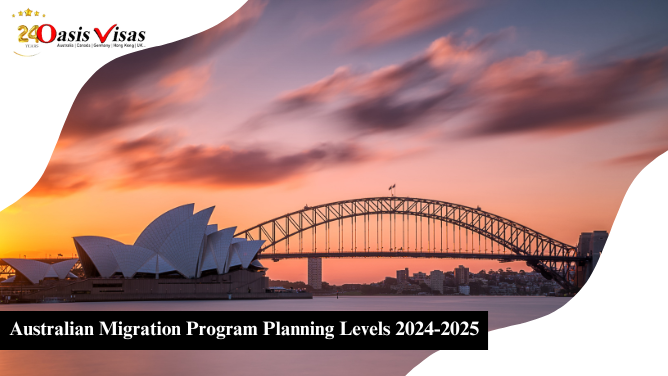
The Australian Migration Program Planning Levels 2024-2025 constitutes the policies of the government on how to handle immigration and how visas are usually allocated to various categories. This was recently updated in Australia as its migration strategy. That strategy is constantly changing to meet needs better with respect for the economy. As such, this change is supposed to be known among prospective migrants, employers as well as policymakers.
Overview of Migration Program
This is the Australian Migration Program, which is designed in a way to increase the population of the country through allowing competent members of society and their families from the rest of the world into the country. Of these, annually, labor market demands and economic conditions, among others, are assessed to present the basis on which the Australian government sets and reviews the levels of migration planning for the country. This will make sure that the system of migration serves its purposes to the nation by helping contribute to its growth and richness and to the tapestry of diversity in the land.
Migration Program Objectives
The migration program is set to have the following objectives:
- Economic Growth: Skilled workers are brought into the nation to fill the critical sectors’ labor shortages, thus contributing to economic growth and productivity.
- Family Reunification: Migrant family reunification encourages social cohesion and cohesive society.
- Cultural Diversity: Migrant population in Australia would significantly contribute to rich cultural diversity in Australian society which forms the vibrant cultural life and enlivens the societies.
- Regional Development: Migration to regional areas would create economic opportunities in the regional areas and also ensure balanced populations at locations in the urban.
Changes in Planning Levels
The Australian government unveiled a raft of changes in the migration planning levels for 2024-2025 compared to the level of 2023-2024. Below is a table summarizing the different visa streams and their corresponding migration planning levels:
| Visa Stream | Visa Category | 2023–24 Planning Levels | 2024–25 Planning Levels |
| Skill | Employer Sponsored | 36,825 | 44,000 |
| Skilled Independent | 30,375 | 16,900 | |
| Regional | 32,300 | 33,000 | |
| State/Territory Nominated | 30,400 | 33,000 | |
| Business Innovation & Investment | 1,900 | 1,000 | |
| Global Talent (Independent) | 5,000 | 4,000 | |
| Distinguished Talent | 300 | 300 | |
| Skill Total | 137,100 | 132,200 | |
| Family | Partner1 | 40,500 | 40,500 |
| Parent | 8,500 | 8,500 | |
| Child1 | 3,000 | 3,000 | |
| Other Family | 500 | 500 | |
| Family Total | 52,500 | 52,500 | |
| Special Eligibility | 400 | 300 | |
| Total Migration Program | 190,000 | 185,000 |
Major Changes in Visa Categories:
- Employer Sponsored Visas Allocation for Employer Sponsored visas is going up since it was 36,825 in the year 2023-24 while it now stands at 44,000 in the year 2024-25. This hence reflects a shift of policy to fill this labor market gap with urgent need and skill-based migration. This will thus help many employers across a wide range of industries facing skills shortages fill up those gaps to take their businesses forward.
- Skilled Independent Visas Planning for Skilled Independent visas stood at 30% lower levels compared to the previous year with figures standing at 16 900. It would perhaps be a strategic change in direction towards other categories and types of visas that would go to better utilize current economic needs. It therefore highlights the necessity of the same migrants-to-be to obtain a job offer or sponsorship.
- Regional Visas Allocation for regional visas has increased by small increase of 32,300 to 33,000. This clearly shows that the government intends to promote migration to less populated areas to redistribute the population and seek to overcome regional skills deficits.
- State/Territory Nominated Visas The planning level for State/Territory Nominated visas has been raised to 33,000 from 30,400 and will be redirected to assist states and territories to nominate people to meet specific needs.
- Business Innovation & Investment This line has been reduced, from 1,900 to 1,000, which would appear to rebalance what Australia needs to attract in terms of business and investment migrants. This could encourage more focused efforts to attract entrepreneurs who could really contribute to the economy.
- Global Talent Visas Even though the headcount for Global Talent (Independent) visas has been cut across equally too, from 5,000 to 4,000, targeting niche markets with highly skilled people will likely not be left as loose as the initial signaling had suggested. This will raise an implication that the Government is interested in attracting those people whose skills fill gaps in the Australian labour market.
- Family Visas No change is visible in the planning levels for Family visa category. The level of steady numbers would portray the seriousness towards family reunification, which is one of the most fundamental principles of the immigration policy of Australia. For Partner, Parent, and Child visas, also the same level prevails, which portrays the readiness of the government to help families who plan to settle in Australia.
- Special Eligibility Visas This has reduced to 100 by 400 to 300, which is probably a stricter position regarding special cases for inclusion outside the mainstream visa classes.
Impact on Migrants
The interested migrants will be affected under the new Australian Migration Program Planning Levels 2024-2025. The interested migrants should pay much attention to those changes, especially in the skills categories that have undergone extreme changes.
In this regard, as much importance is being given to Employer Sponsored visas it is basically indicated that a skilled worker should look out for employment opportunities that will bring about sponsorship. The same may either be through networking with the employers, skill up-gradation, or in some cases, qualification achieved that is accepted in Australia. More so, awareness of the details of every category will likely guide the applicant to adjust his skills and experiences with the needs of Australia for migration.
This stability in family visa allocations will provide predictability for families. Those intending to join their family members will continue to plan migration pathways knowing that the Government is committed to a focus on family reunification.
Migration Planning
The Steps Potential migrants should consider when planning their migration to Australia:
- Visas: Research visa options-understand the different visa streams and their requirements. This will help decide which route best fits your circumstances in relation to the criteria that applies to each category.
- Skill Assessment: Sometimes an appropriate skill assessment is required for a skilled migrant. It not only proves you will have qualifications and experience qualified to Australian standards but often connects you with the right authorities to help this process.
- Seek a job. For example, while looking for employment in Australia, one is likely to find more opportunities regarding an Employer Sponsored visa. So, browse through the job boards, networking, and professional associations.
- Stay updated. Department of Home Affairs will keep you informed on the new development within the migration policies, as well as the availability of the visas, application procedures.
- Consult a Registered Migrations Agent: A registered migration agent may be helpful at various stages of application and can provide guidance throughout the process of making an application.
The Australian Migration Program Planning Levels 2024-2025 depicts the process of the formation of migration for Australia compatible with its economic as well as social system. Revisions in visa categories and planning levels show that more scope is provided to describe the better kind of landscape for migration, thus making strategic decisions better.
With regards to Australia, in as much as the country continues to shape itself towards global change, being on top of migration policies and planning levels would then be crucial for anyone wanting to make Australia his or her new home. A more adequate understanding of implications would then help prospective migrants navigate this process much better and maximize chances for success within this highly competitive environment.









